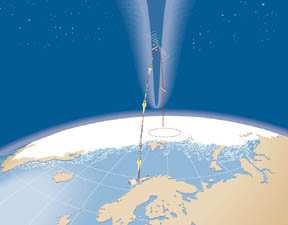Solar Wind Putting the Squeeze on Earth's Atmosphere
NASA researchers used the Polar spacecraft to find evidence that solar storms push part of our atmosphere into space. The force of the solar particles hitting the Earth's ionosphere squeeze the gases into space. "We now have the first direct, quantifiable evidence that disturbances in the solar wind produce changes in the flow of ions out of the ionosphere," said Dr. Thomas E. Moore, principal investigator for Polar's Thermal Ion Dynamics Experiment (TIDE). The TIDE instrument was specially designed to measure ions such as oxygen that leave the atmosphere. In September, 1998, a coronal mass ejection increased the density of the solar wind that strikes Earth. TIDI was able to measure increases in the gases being pushed out of the atmosphere. The atmosphere lost a few hundred tons of gas. That's similar to the mass of the oxygen in the Louisiana Superdome.What's New on the Site?
When Nature Strikes - Earthquakes
When Nature Strikes - Volcanoes
When Nature Strikes: Tsunami Classroom Activity
When Nature Strikes: Wildfires - Why are they a challenge to stop?
Windows to the Universe Community | |
News | Opportunities |
You might also be interested in:

Cool It! Game
Check out our online store - minerals, fossils, books, activities, jewelry, and household items!...more
Scientists Successfully Launch CAPER
After waiting weeks for the right solar and atmospheric conditions, scientists were finally able to launch the Cleft Acceleration Plasma Experimental Rocket (CAPER) from Andoya Rocket Range in Norway....more
1999--A Year in Review...
It was another exciting and frustrating year for the space science program. It seemed that every step forward led to one backwards. Either way, NASA led the way to a great century of discovery. Unfortunately,...more
STS-95 Launch: "Let the wings of Discovery lift us on to the future."
The Space Shuttle Discovery lifted off from Kennedy Space Center at 2:19 p.m. EST, October 29th. The sky was clear and the weather was great as Discovery took 8 1/2 minutes to reach orbit for the Unitied...more
Moon Found Orbiting Asteroid
A moon was discovered orbiting the asteroid, Eugenia. This is only the second time in history that a satellite has been seen circling an asteroid. A special mirror allowed scientists to find the moon...more
U.S. is Fed Up with Russia
Will Russia ever put the service module for the International Space Station in space? NASA officials are demanding an answer from the Russian government. The necessary service module is currently waiting...more
More on Recent Coronal Mass Ejection
During a period of about two days in early May, 1998, the ACE spacecraft was immersed in plasma associated with a coronal mass ejection (CME). The SWICS instrument on ACE, which determines unambiguously...more
Mother Nature's Air Conditioning
J.S. Maini of the Canadian Forest Service has referred to forests as the "heart and lungs of the world." Forests reduce soil erosion, maintain water quality, contribute to atmospheric humidity and cloud...morePlease log in
Science Blogs
Real Climate: climate science from climate scientists

Windows to the Universe, a project of the National Earth Science Teachers Association, is sponsored in part is sponsored in part through grants from federal agencies (NASA and NOAA), and partnerships with affiliated organizations, including the American Geophysical Union, the Howard Hughes Medical Institute, the Earth System Information Partnership, the American Meteorological Society, the National Center for Science Education, and TERC. The American Geophysical Union and the American Geosciences Institute are Windows to the Universe Founding Partners. NESTA welcomes new Institutional Affiliates in support of our ongoing programs, as well as collaborations on new projects. Contact NESTA for more information.





